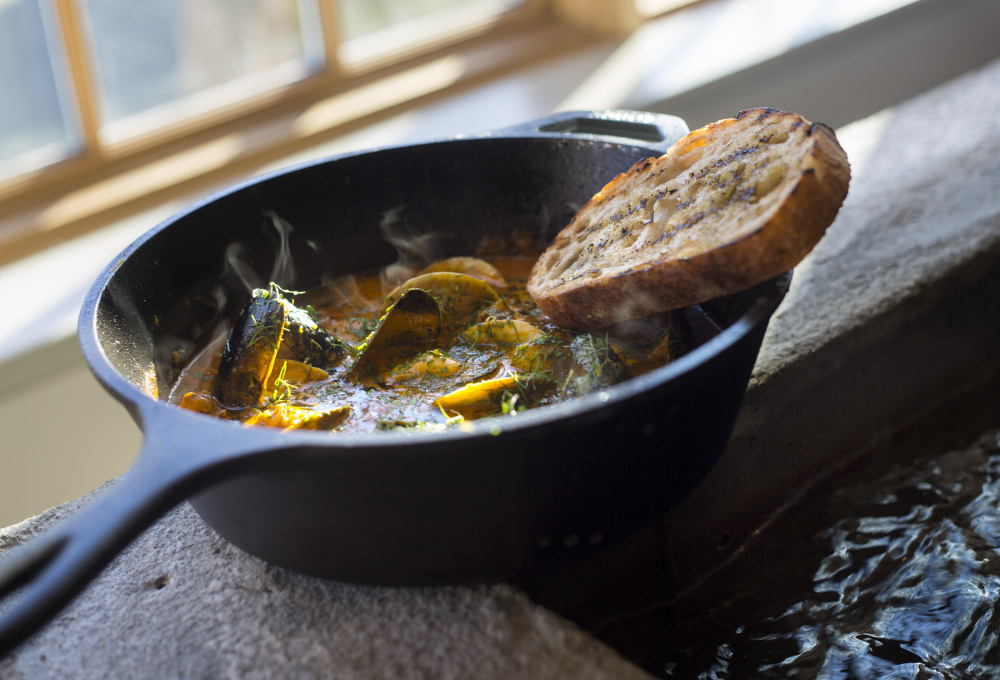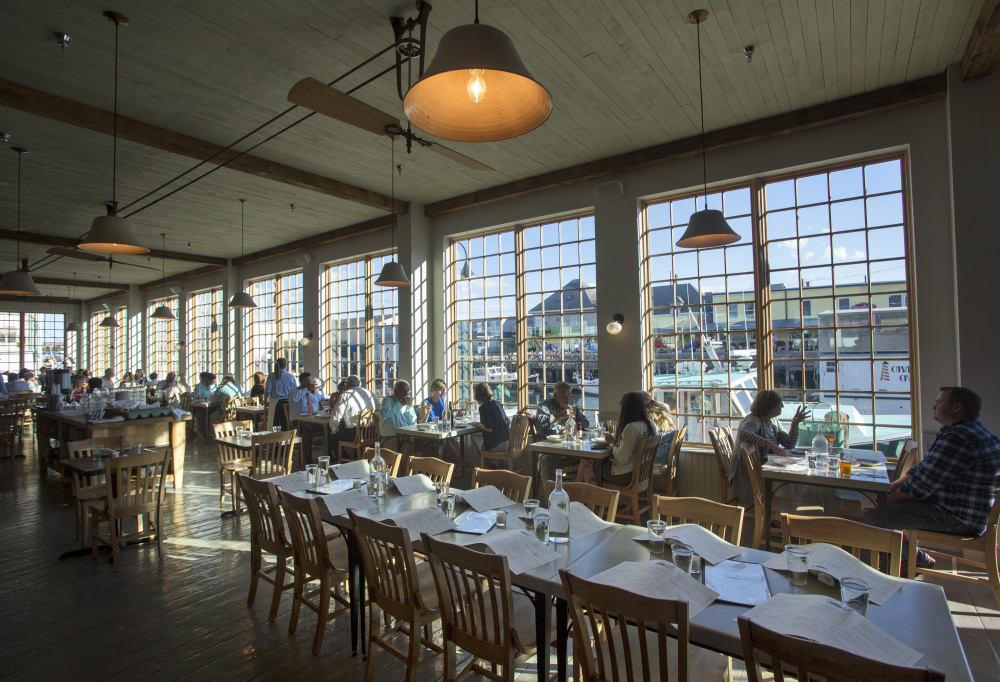Walking into the dining room at Scales, I couldn’t keep my focus on the person checking our reservation at the reception desk.
My attention kept pinging away from the open kitchen, the chic, sanded driftwood booths and sturdy steel tables, up to the ceiling. Here, mounted like a broken slot machine hemorrhaging silver coins, was my distraction: a device that spluttered and excreted something every few seconds into a black rolling wheelbarrow yards below. “It’s ice,” the host told me, without my having to ask, “For the raw bar. I don’t know why they have it there.” When I remarked that I had never seen anything like it, she looked at me conspiratorially and said quietly, “Some things around here don’t make much sense.”
Almost immediately, I saw that she might be on to something. It started with the restaurant’s disorienting “team service” system: Greeting, seating, table maintenance, order-taking and food delivery are assigned to groups of waitstaff, rather than to specific individuals.
In theory, this no-territory scheme allows any server to assist any diner, at any time – a clever idea, especially in a restaurant so large it can seat more than 160 people at a time. But in practice, there are complications: “It has actually created some communication challenges between servers and me,” executive chef Mike Smith (formerly chef de cuisine at Toro in Boston) said, “because if I look for someone who rang up a certain ticket, sometimes I just can’t figure out who did it.”
Team service also means that when you come for a meal, you might place an order with one person and then never see him or her again. It’s even more confusing if, as happened to our table, nobody bothers to explain the approach before (or during) the meal. As someone who spent 20 minutes of one visit trying to figure out which server to ask to change a wine order, I’m not a big fan of a system that requires instructions on how to be a diner.
Luckily, eating at Scales was much less complicated than ordering. The menu is a diverse collection of cold, hot, cooked and raw seafood items, along with sandwiches and even a few non-seafood options like a mustardy braised short-rib pot roast ($30). According to Smith, “We want to give a nod to old-school American seafood houses, in an upscale way, with something on the menu for everyone.”
Some of Scales’ best dishes are the ones that hew closest to the simple, original ideas that made them summer shack classics, like the fried whole belly clams ($16 side dish, $24 plate) coated in a nostalgic, rustic dredge of plain all-purpose flour and cracker meal, and plated with a house-made tartar sauce that incorporates excellent homemade pickles. Or the roasted lobster ($37), split and packed tight with a sweet-savory stuffing made from panko, Ritz crackers, fennel pollen and delicate Espelette pepper, all showered in clarified butter and served in its roasting pan.
Both dishes were great matches for a sake-and-gin Maine Wharf ($12), a cocktail made slightly savory with Maine sugar kelp and celery – think of it as a barely dirty martini.
The fish and shellfish stew ($28), while not technically a standard of coastal fish shacks, also benefits from fidelity to its conceptual ancestors: cioppino and bouillabaisse. In the fragrant, spicy broth float chunks of swordfish, littlenecks and most importantly, loads of tender pieces of squid, all bubbling under a slab of grilled bread big enough to act as a flotation device. This hearty, mostly-loyal take on an old standard gets a new spring in its step courtesy of fruity Calabrian chilies and a final-second sprinkling of orange zest and fennel fronds. You’ll want to drape your napkin over your head and inhale the steam coming off this stew.
The lobster bisque ($9 for a cup, $14 for a bowl) was just as impressive and featured a heavily fortified lobster stock with a mineral, raisiny lushness, thanks to the sweet sherry in the broth, and – best of all – a generous mound of warm lobster meat floated on top that had been finished separately in brown butter to keep it from getting overcooked.
Only a few dishes left us scratching our heads, like the seared scallops ($33) with wild fennel sausage. Served in a gigantic cast iron pan that was as hot as a meteorite, this was a tricky dish to eat without incurring a few burns (as one of our many servers did). And after a few bites, we weren’t really sure if we were willing to risk it. The scallops showed off a lovely sear, but alongside bitter charred endive and a palate-neutralizing cream sauce, any delicate flavor from the sausage and fennel disappeared.
Smith told me later that the dish was based on a classic scallop preparation served with blood sausage, but like a low resolution scan of a faxed photograph, this blurry version bore little resemblance to a much better original.
The sides were also hit or miss. The Hasselback potato ($8.50), a debauched riff on a baked potato that has been sliced to look like a rack of poker chips, was first cooked with butter, then deep fried and garnished with onions and bacon. Heart-healthy? No. A hit? Absolutely.
The Parker House rolls ($4), on the other hand, which look more like semicircular Chinese buns, were sticky and overbaked – not the airy, fluffy, milk dough rolls you’d expect. Worse, one miserly portion consisted of two tiny, desultory rolls. Definitely a miss.
As we sat sharing a serving of the delightfully tart rhubarb compote and strawberry-milk-dusted chiffon cake ($9), admiring the restaurant’s wharfside views, we were distracted again, this time not by the ice machine. Four different servers flitted like hummingbirds over to the table, stopped for a microsecond and then sped away before saying a word. They seemed caught up in a loop of wasted effort, doing work that their colleagues had done mere minutes before.
Still, you have to make some allowances for a Leviathan of a restaurant that can serve hundreds of diners in an evening. Perhaps the team service model needs a few tweaks to eliminate overlaps, or perhaps the whole thing just needs more time to reach a comfortable equilibrium, just as the menu, after several iterations of changes, seems to be doing.
But in a restaurant at this price point – and there is no getting around the fact that these are Boston or New York prices – diners should reasonably expect that all the elements that make up their dining experience reveal careful thought and planning. In the end, everything, from the food to the service, should simply make sense.
Andrew Ross has written about food in the United Kingdom and in New York, where he co-founded NYCnosh, a food website. He and his work have been featured on Martha Stewart Living Radio and in The New York Times. He is an internet researcher and higher education consultant. Contact him at:
Twitter: @AndrewRossME
Send questions/comments to the editors.




